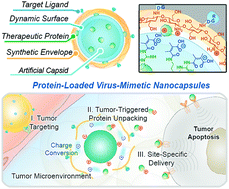Dynamic-responsive virus-mimetic nanocapsules facilitate protein drug penetration and extracellular-specific unpacking for antitumor treatment†
Abstract
Protein-based drugs have been demonstrating great potential for the treatment of various diseases, but most of them encounter many difficulties in clinical trials or uses, such as instability, low bioavailability, and poor in vivo efficacy. In this work, we developed virus-mimetic nanocapsules (VMNs) for improving protein systemic delivery and pharmaceutical effects through bioinspired macromolecular and supramolecular engineering. These VMNs possessed hierarchical nanostructures including artificial capsids, encapsulated proteins, and synthetic envelopes. These dynamic-responsive VMNs can harbor protein drugs, resist protein adsorption, target solid tumors, penetrate into deep tissue, and site-specifically unpack protein drugs. Through surmounting the sequential physio-pathological barriers, protein-loaded VMNs successfully maximized the in vitro and in vivo therapeutic efficacy of proteins, giving a promising strategy to address dilemmas on clinical TRAIL therapy. This study is expected to promote in vivo treatment outcomes and clinical transformation of protein drugs.



 Please wait while we load your content...
Please wait while we load your content...